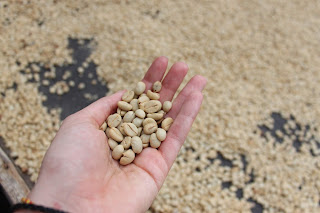When Hanfei and I had visited a privately owned coffee farm, we learned a lot about the coffee making process. This blog post will share with you the interesting discoveries we made that day about coffee.
The coffee farm we visited is small, therefore, the coffee is not exported. The farm is family run and they profit from selling their coffee and providing coffee processing tours.
Here is some of what we learned…
The first step in the coffee making process is the planting of the seed. Once the plant has grown into maturity and it produces coffee. The coffee at this point is in the form little red seeds or cherries about the size of a marble. With this you peel away the red part of the seed to get to the bean. It looks just like a regular coffee bean however it is pale and a bit slimy on the outside from the red seed covering. At this point in the process, you can suck on the bean to taste a sweet flavor. During the tour, we took the seeds in this form and planted in a little nursery for them to grow into more coffee plants.
 |
| The coffee cherries |
 |
| The coffee beans once planted and starting to grow |
 |
| Walking through the plantations and picking the best coffee cherries |
The next step for the coffee process is the placing of seeds into a special machine that peals the cherry so that only the bean is left. At the farm we were at, the cherries were hand picked by two men, who were paid by the kilo.
The third step in the coffee making process is the drying out of the bean. The slimy outer layer, previously described as tasty, must be removed by being laid out in the sun to dry. At this step in the process, the bean can be recognized as the coffee beans we have at home, however, the outer layer still appears pale. The best beans are chosen and by hand the soft shell is peeled away.
The next step to the coffee making process is roasting the beans. Since we were at a small farm, they did it in a pot over the stove, the artisanal way. Larger corporations have special equipment for equally roasting all the coffee beans. Once roasted, the coffee can be sold as whole beans or it is ground down and bagged to what we normally purchase in our stores in North America.
Finally, the coffee is enjoyed. At the plantation the hosts made us little espressos, allowing us to taste the rich flavor while enjoying a fantastic view of the coffee plantations.
 |
| The view of the farm |
 |
| Coffee with a view |
(Please note that this information came from what I remember from the tour. If I have made any mistakes or if you have corrections for me please comment below).
























